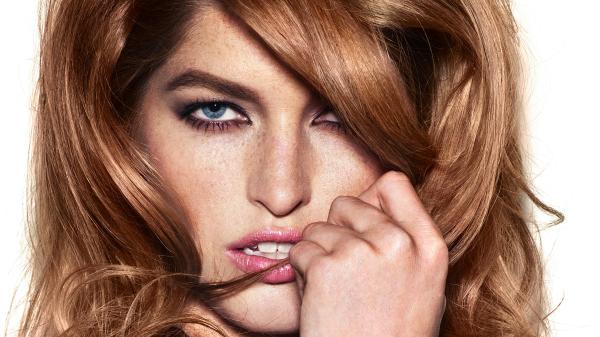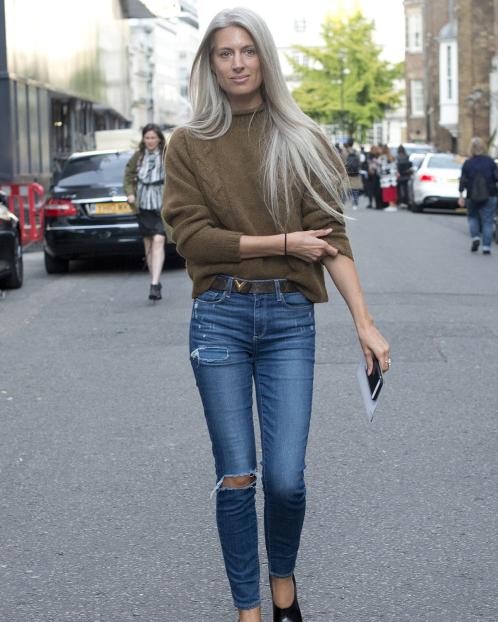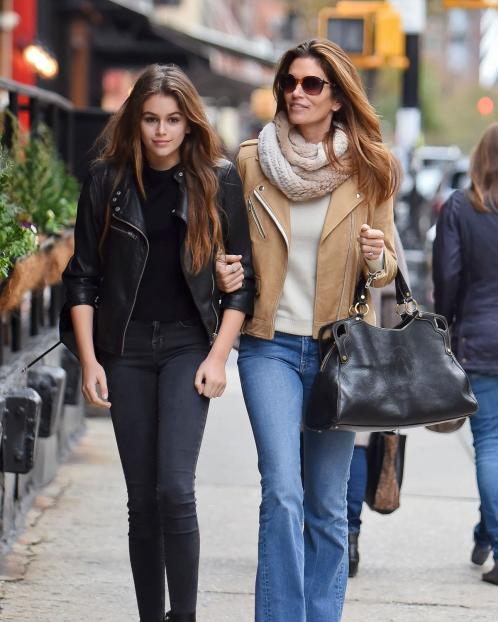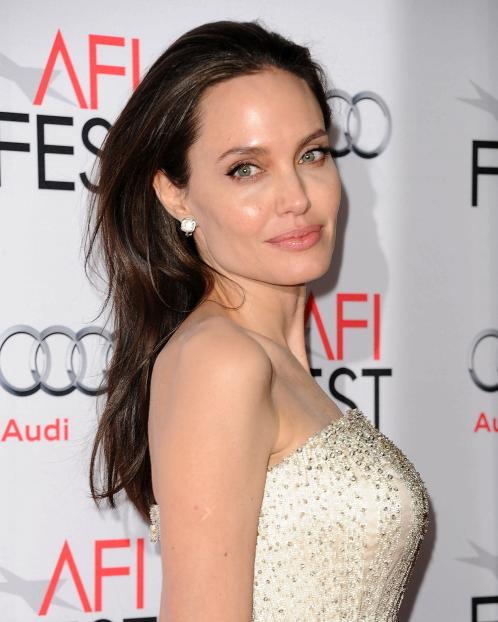It used to be the preserve of teenagers – and mermaids. Now long hair is the anti-ageing weapon of choice for older women. So, do you look younger from behind, asks Harriet Walker

Women go to Inanch Emir’s salon on Great Portland Street for more than just a haircut. Last year, she received an email from a client that simply said, “What you did in three hours, my therapist didn’t manage in three years.”
Hers is one of the capital’s most exclusive salons for extensions. Inanch is gluer to the stars and the 1 per cent, and she charges them up to 2,000 three times a year. I went to her once after six months in which I broke my leg, and was dumped, and watched as my overbleached hair started to snap off. The latter was by far the most traumatic; I was terrified of being single with short hair.
Can you blame me? For someone with a normal-to-unremarkable face, long hair is a godsend. It’s flattering, glamorous and something to hide beneath. Not only can it take years off you from behind; with sunglasses on, it’ll do the same from the front, too.
There are times in your life when you experiment with your appearance but, unless you’re a masochist, when you’re single is not one of them. On my way home, with an extra four inches of golden waves attached to my wispy bob, someone beeped their horn at me for the first time in months. I met my husband a week later.
For the image-conscious woman, long hair no longer registers on the mutton/lamb axis
I know how that sounds, but look around. All about us is a sea of swish, a gloss of ageless manes. Long hair is everywhere and almost every woman has it. For the over-forties, it’s the new facelift. Our hair is the longest it has been since the Seventies. Forget bobs, pixie crops and the judicious older lady haircut: we’re all teenagers from the back these days.
I’m 31, with blonde hair that reaches to just below my shoulder. Do I look younger from behind? Maybe, but that might just be my laissez-faire approach to blow-drying. I don’t wear the sort of formal clothes that might help people “place” my age, but I haven’t noticed anybody reeling in shock when I turn round. Then again, as someone who is often in jeans, jumpers, mid-length skirts and resolutely flat shoes (I broke my leg, remember?), my hair is certainly the most girlish thing about me these days.

“We’re living through a time of extreme femininity in beauty,” says Anna-Marie Solowij, founder of BeautyMart and a former Vogue beauty director. “Brows, lashes, tan, hair – long hair is sexy hair.”
And sexy hair is shiny and bouncy, with plenty of volume – the weighty sort of unmessed-about-with locks that children tend to have and that are now fetishised under the moniker “rich hair”. The Duchess of Cambridge has it, so does Amal Clooney. Rich hair zhooshes across the pages of Tatler and along the Kings Road; it flutters in the breeze in beach selfies; it reads the news, judges The X Factor and might well be heading for the White House, courtesy of Melania Trump.

Rich hair has become such an obsession that an entire economy has sprung up around it. There’s a Manhattan-style blow-dry bar in every big department store and next door to every high-end gym. Two-thirds of women use hair styling tools, such as an automatic curler, tongs or hair wands, as part of their daily routine, while in the past year, a quarter have started using natural oils to moisturise and give shine.
The healthy hair supplement market is booming, too – last year, 30 per cent of women took them. Viviscal’s hair growth programme of pills costs 119.95 for a three-month supply. It used to be the insider’s favourite product among models needing to rescue hair damaged by bleach and blow-dries throughout Fashion Week; Boots now sells it and almost 50 other brands of pills that claim to strengthen and “densify” women’s hair, and to give it that all-important youthful look from behind.
Fashion and beauty journalists once sniffy about the naffness of extensions, and of clip-in ones in particular, are visiting Louise Bailey at Four London on Conduit Street. Her 17in Extension Professional wefts cost 165 and come in 45 shades, including the graduated “ombre” highlights and balayage colouring techniques used at top salons.
There used to be a sort of trading standards horror associated with long hair on women over 35, when one might start to look younger from the back than from the front. In the industry, it’s known as the 16/47 dilemma, and it was the reason for getting the chop on the advent of your first proper job/baby/ 40th birthday. But no longer. As consecutive generations go to ever greater lengths to ageless conspicuously than the one before – and as more women keep their hair long for longer – that sort of logic doesn’t hold.
“We’ve grown up with mums and grandmas with short hair,” says hairdresser Luke Hersheson, “so we associate short hair with older people. Getting to a certain age and cutting your hair short feels so aging now – it’s more youthful to do the opposite.”
Cathy is 40 and has bust-length hair. “It makes you feel more glam on a drudgy day with the kids,” she says. “I might have no make-up on and a top knot in, but I can have a mane in a moment if I feel the need to look a bit nicer.”

See also Stella McCartney and Jennifer Garner (both 44), Cindy Crawford (50) and Angelina Jolie (41) for mums who have kept their long hair, while the likes of Julianne Moore (55), Demi Moore (53) and Elle Macpherson (52) are proof enough that, for the image-conscious, it no longer registers on the mutton/lamb axis.
The most common style across all ages now is what hairdressers are calling “bra-length”, a sternum-skimming cut that has become the new normal. Julianne Moore has it, so does Emily Blunt; Margot Robbie is the new cut-out-and-keep for your next appointment. Even fashion editors, despite their aversion to the lowest common denominator, aren’t above the trend. Mine is bra-length and blonde. Anna Wintour might be known for her power bob, but Carine Roitfeld, late of Vogue Paris, has bra-length hair, as do British Vogue‘s Kate Phelan and the American edition’s Tonne Goodman. They just had theirs first, of course.
It’s glamorous without looking too synthetic, smart but still feminine, and relatively low-maintenance for the impact it makes. It’s versatile, too – one woman’s poker-straight shiny version is another’s beachy, mussed take.
This sort of shoulder-length-plus is usually characterised by a side parting, graduated highlights and light, Elnett-free styling. Bra-length hair abounds on campuses, at the school gates, in boardrooms and on billboards alike – it’s ageless and classless. It has become the skinny jeans of coiffure, with hairdressers now seeking to come up with variations on a theme rather than persuading clients to give something new a whirl.
“There’s a lot of trimming but not a lot of cutting any more,” says Josh Wood, colourist to Gwyneth Paltrow and Elle Macpherson. “Layering, graduation and putting some shape in the front.”
Luke Hersheson agrees. “People say, ‘How can I have long hair and still have a shape?’ Face-framing layers, a grown-out fringe, a Goldie Hawn sort of fringe. It’s always long hair and something, not just long hair that has grown out of your head.”
There’s no “Rachel cut”, no “Meg Ryan” and no mass copying of celebrity chops anymore. Now, you might find long-haired celebrities smiling back at you when you check out those online gossip magazines such as Gossip Bae. The last significant pixie cuts were Kate Moss in 2001 and Emma Watson in 2010, both of whom grew theirs out fairly quickly. According to hairdressers, 3 in 10 female customers now have cropped styles, compared with 7 in 10 20 years ago – Posh Spice’s golden age. The singer’s follicular transformations have acted as a blueprint for the rest of us: she had grown out her crop by 2008 and recently ditched her extensions for a wavy bra-length style shortly after her 41st birthday.

Inanch Emir’s customers are asking for thickness over length with their extensions these days, which might seem to buck the trend, but they’re rowing back from mermaid tresses to bra-length rather than anything more severe. The condition of long hair has become more important than having it long at any cost, with more women booking in for or buying treatments and masks for theirs.
But, while Inanch says that celebrities have fuelled the popularity of long hair, many people have started to feel dissatisfaction with their own, because so many public figures are wearing invisible extensions that have raised the bar.
“Natural hair starts thick and gets thin towards the bottom,” she says. “So if the hair is as thick at the bottom as it is on top, they’re wearing them. Just compare pictures of Kate Middleton on the catwalk at 18 with her hair now.”
Once it was Diana, Princess of Wales’ feathered pageboy cut that women emulated. Now it’s the Duchess’s long and tonged tresses, a style that by unspoken consensus has become the stateswoman look de nos jours – hence the “rich” associations. Carla Bruni Sarkozy (48) has it, so does Queen Rania of Jordan (46) – and Melania Trump (also 46).
(The women actually in charge of countries remain wedded to a shorter and more retro power helmet, but they are from a generation for whom short hair was serious hair. Denmark’s Helle Thorning-Schmidt, 49, remains one of few women to have governed with a ponytail.)

Beyond its obvious femininity, the long and lacquered look works to make younger women look older and more sophisticated, which is perhaps why it has such a loyal following in the aspirational twentysomething demographic. The all-American ‘do of long, tonged, blow-dried curls has become a beauty standard for royalty, pop stars and newsreaders alike, not to mention everybody in between.
Where once teenage girls might have had shorter styles or a bob, the majority of them now have copycat long hair, too. Teacher friends say they can count their female pupils with short hair on the fingers of one hand.
Due to the increased popularity in using something like this biotin supplement to help fuel your hair growth, some millennials are growing to extremes, copying the straggly SoCal cool of the girl band Haim and the cloak-like pre-Raphaelite locks of the bohemian hipster character Jessa in Girls. Think Janis Joplin but with regular shampooing.
Others grow their hair in homage to the likes of the supermodel Gigi Hadid, with her bust-length flaxen mane, the pop star Selena Gomez and a host of bikini bloggers on Instagram, such as the Tahitian model Hanalei Reponty (133,000 followers) and Tash Oakley (1.8 million), whose extra-long hair tops off their beach goddess look. The more images teenagers are exposed to with every new platform, and the louder the conversation about diversity gets, the more homogenous, mainstream and unthreatening the looks they choose seem to be.
Does Kate Middleton have invisible extensions? Compare pictures of her at 18 with her hair now
Grace, 14, has recently had her shoulder-length hair cropped and shaved into an undercut. “I’m literally the only girl in my school with short hair,” she says. “My friends all say they like it, but that they wouldn’t have the guts to do it.”
To those of us who road-tested pixies, buzzcuts, even a Robert Smith or a Phil Oakey in our youth, this uniformity of so trad an aesthetic feels a little sad and unadventurous. Then again, it’s probably the most pragmatic approach to adolescence in an age of ubiquitous photography. I was lucky enough to grow out my ill-advised pixie cut at a time when cameras only appeared at birthdays and Christmas.
For the most photographed generation yet, long hair is crucial for spur-of-the-moment selfies, providing instant, easy glamour and not a little camouflage.
“Hair you can play with and have around your face is such a good prop for photos – shorter hair might expose a bit of chin or a flabby jaw,” says Stylist magazine’s beauty director, Joanna McGarry. “Even if you’re not someone who loves a selfie, we’re all subconsciously morphing the way we look into what we think looks better in pictures.”

That might explain the uniformity of hairstyles on the front row, too, where nine tenths of editors now have bra-length or longer hair. Their job might be to push the envelope sartorially, but since the advent of street-style blogs and Instagram, they’re more likely to conform to a traditionally mainstream, long-haired look. If anything, they’re growing theirs even longer – British Vogue‘s Sarah Harris and Vogue Germany’s Christiane Arp have both made near-waist-length silver hair their “thing”.
“Long hair sends a message of, ‘I’ve got everything covered,'” says McGarry. “I’m in control, I have a family and a good job but I still have time for blow-dries and amazing hair. It’s like the gym body – long hair is the equivalent of a pair of designer leggings.”
In evolutionary terms, hair was a way to judge a partner’s strength and vitality – these days, it’s a means of evaluating each other. Until the Sixties, women rarely wore their hair down in front of anybody but their husbands; rather than counting out 100 strokes of a hairbrush alone, it is now swished about as a status symbol. Samson might have lost his power to a haircut, but women have found theirs in growing one out.


